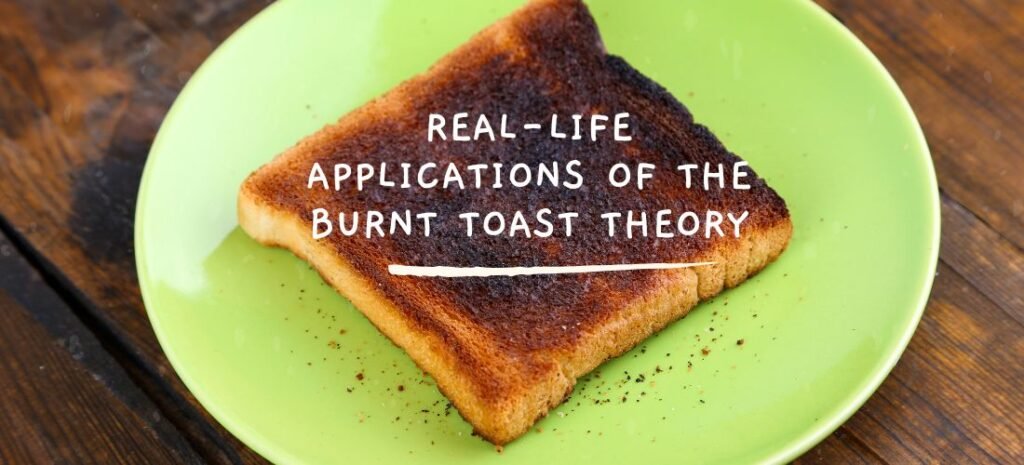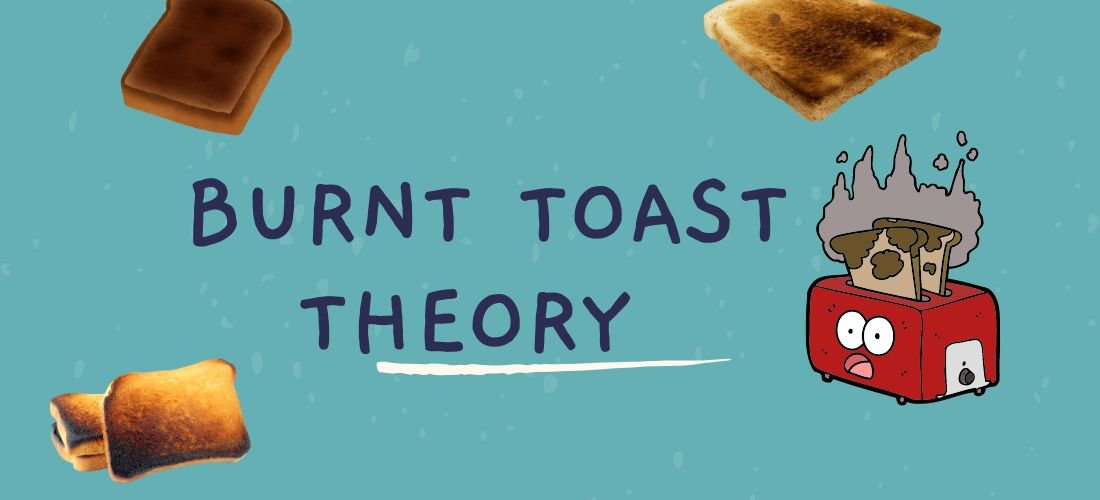Have you ever experienced a morning mishap where your toast comes out of the toaster slightly charred? Well, what if I told you that this simple burnt toast moment could hold the key to understanding life’s little accidents and setbacks? Enter the intriguing Burnt Toast Theory – a concept that delves into how we perceive and react to unexpected events in our lives. Join me on a journey as we explore the science, real-life applications, relationship dynamics, professional insights, personal growth aspects, and more surrounding the enigmatic Burnt Toast Theory. So grab a cup of coffee (and maybe some non-burnt toast), and let’s dive in!
What is the Burnt Toast Theory?
The Burnt Toast Theory is a fascinating concept that uses the relatable experience of burnt toast to shed light on how we perceive and handle life’s mishaps. Just like burnt toast catches us off guard, unexpected events in our lives can trigger various responses based on our mindset. The theory suggests that our reactions to minor accidents or setbacks can reveal deeper insights into our overall approach to challenges.
By likening life’s hiccups to a piece of burnt toast, this theory encourages us to reflect on how we interpret and adapt to unplanned circumstances. It invites us to consider whether we view these incidents as mere annoyances or opportunities for growth and resilience. Embracing the Burnt Toast Theory may help us shift our perspective towards embracing imperfections and finding value in the unexpected twists life throws our way.
Read Also: What Is Simp City Forum & Its Uses? | Jeinz Macias
The Science Behind the Burnt Toast Theory
Have you ever wondered about the science behind the Burnt Toast Theory? It’s not just a whimsical idea but actually rooted in psychology and cognitive behavior. When we focus on negative occurrences like burnt toast, our brains tend to amplify these small mishaps, influencing our mood and overall outlook.
Neurologically speaking, our brains are wired to pay more attention to negative experiences due to evolutionary reasons. This phenomenon is known as negativity bias. So, when we encounter a minor inconvenience like burnt toast, it can trigger a cascade of negative thoughts and emotions.
Additionally, research shows that dwelling on these small setbacks can lead to increased stress levels and decreased resilience over time. By understanding the science behind the Burnt Toast Theory, we can learn how to rewire our brains towards more positive thinking patterns for improved well-being.
Real-Life Applications of the Burnt Toast Theory

Ever found yourself running late for work, only to spill coffee on your shirt right before an important meeting? That’s the Burnt Toast Theory in action. It’s those little everyday mishaps that seem to happen at the worst possible times.
Whether it’s a sudden rainstorm during your outdoor event or getting stuck in traffic on the way to a movie, these inconveniences can be frustrating. But understanding the Burnt Toast Theory can help you navigate these situations with more grace and resilience.
By embracing the idea that life is unpredictable and accidents are bound to happen, you can learn to adapt and roll with the punches. Instead of letting setbacks ruin your day, see them as opportunities for growth and learning.
Applying this mindset in real life means being flexible, staying positive, and finding solutions rather than dwelling on problems. So next time you encounter a burnt toast moment, remember: it’s just another chance to practice patience and resilience.
The Burnt Toast Theory in Relationships
Relationships, much like toasting bread, can sometimes result in unexpected outcomes. The Burnt Toast Theory teaches us that even in the best of relationships, there may be moments of imperfection or challenges to overcome. Just as burnt toast can still be enjoyed with a little extra butter or jam, relationships too can thrive when faced with adversity.
In relationships, it’s essential to remember that everyone has their own unique quirks and flaws. By embracing these imperfections and finding ways to navigate through them together, stronger bonds are formed. Communication plays a crucial role in ensuring that misunderstandings are clarified promptly and feelings are validated.
Applying the Burnt Toast Theory in relationships involves showing empathy, understanding, and patience towards your partner. Instead of focusing on small mistakes or disagreements, it’s important to look at the bigger picture – the love and connection shared between two individuals. In essence, by accepting each other’s burnt edges and learning from them, relationships can grow stronger over time.
Professional Life and the Burnt Toast Theory
Professional life is like a delicate dance, where unexpected mishaps can occur at any moment. The Burnt Toast Theory reminds us that even in our careers, mistakes are inevitable. Just like burnt toast teaches us to be more mindful in the kitchen, setbacks at work can teach us valuable lessons.
In the corporate world, projects may not always go as planned – deadlines might get missed or presentations could fall flat. But just like with burnt toast, it’s all about how we choose to respond. Do we dwell on the mistake or do we learn from it and move forward?
Embracing the Burnt Toast Theory in our professional lives means acknowledging that perfection is unattainable. It encourages us to view failures as opportunities for growth and development. By accepting that missteps are part of the journey, we can approach challenges with resilience and grace.
Applying this theory at work allows us to cultivate a mindset of continuous improvement and adaptability. Instead of being discouraged by setbacks, we can use them as stepping stones towards success. Remember, just like burnt toast adds flavor to breakfast, overcoming obstacles can add depth to our careers.
Incorporating the Burnt Toast Theory into our professional ethos fosters a culture of learning and innovation within organizations. By embracing imperfection and valuing resilience, teams can navigate uncertainties with confidence and creativity alike toasted bread – sometimes slightly singed but still full of potential!
The Burnt Toast Theory and Personal Growth
Have you ever considered how the Burnt Toast Theory can reflect personal growth in our lives? Just like burnt toast teaches us to pay attention and be present in the moment, personal growth is often sparked by moments of discomfort or mistakes. Embracing these experiences allows us to learn and evolve.
Personal growth involves acknowledging our flaws, just like recognizing a piece of burnt toast. By accepting imperfections, we open ourselves up to new possibilities for development and self-improvement.
The Burnt Toast Theory encourages us to see setbacks as opportunities for growth rather than failures. It reminds us that even when things don’t go as planned, there is always a chance to learn and move forward.
Incorporating this mindset into our daily lives can lead to significant personal growth over time. Whether it’s learning from past mistakes or facing challenges head-on, adopting the Burnt Toast Theory can help us navigate life with resilience and optimism.
The Role of Perception
Perception plays a crucial role in how we interpret the world around us. It’s like wearing a pair of tinted glasses that color our reality. Our perceptions are shaped by our past experiences, beliefs, and emotions, influencing how we see situations and people.
What one person may perceive as a setback, another might see as an opportunity for growth. This difference in perception can lead to varying reactions and outcomes. The way we perceive challenges can either limit us or propel us forward.
By becoming aware of our perceptions and actively choosing how to view a situation, we can shift our mindset towards positivity and resilience. Changing our perspective doesn’t change the facts but it does alter how we respond to them.
Understanding the role of perception allows us to navigate life’s ups and downs with greater adaptability and grace. It empowers us to choose optimism over pessimism, gratitude over resentment, ultimately shaping our experiences and relationships.
Practical Applications
Practical Applications of the Burnt Toast Theory can be found in daily scenarios where mistakes occur. Embracing imperfections allows for growth and learning in various aspects of life. In relationships, understanding that everyone makes mistakes can lead to forgiveness and stronger bonds.
Professionally, acknowledging mishaps as opportunities for improvement fosters a growth mindset and resilience in the face of challenges. Personal growth is nurtured when individuals learn from their missteps rather than dwelling on them.
Perception plays a key role in applying this theory effectively – viewing errors as stepping stones rather than obstacles can shift one’s mindset positively. By practicing self-compassion and acceptance, individuals can navigate through setbacks with grace.
Applying the Burnt Toast Theory encourages continuous improvement and a willingness to embrace vulnerability.
Criticisms and Misconceptions
As with any theory or concept, the Burnt Toast Theory is not immune to criticisms and misconceptions. Some may argue that it oversimplifies complex situations, reducing them to mere accidents like burnt toast. Others may claim that it promotes a passive acceptance of negative occurrences instead of actively seeking solutions.
Misconceptions about the Burnt Toast Theory often stem from a misunderstanding of its core message. It’s not about embracing failure or settling for less; rather, it emphasizes resilience in the face of setbacks and finding growth opportunities in unexpected places.
Critics might also question the practicality of applying this theory in all aspects of life. While not every situation can be neatly compared to burnt toast, the underlying principle of adapting to unforeseen circumstances remains relevant across various scenarios.
Exploring these criticisms and misconceptions can lead to a deeper understanding and refinement of how we perceive life’s little accidents through the lens of the Burnt Toast Theory.
Conclusion
The Burnt Toast Theory offers a refreshing perspective on life’s inevitable challenges. By embracing this mindset, we can transform setbacks into opportunities for growth and learning. Whether in personal relationships, professional life, or personal development, the Burnt Toast Theory encourages us to see the silver lining in every cloud and to use every “burnt toast” moment as a stepping stone to a better future.
Read Also: Pi123 | FintechZoom Credit Cards
Frequently Asked Questions :
Q1: What is the Burnt Toast Theory?
A1: The Burnt Toast Theory, also known as the negativity bias, suggests that our brains respond more strongly to negative experiences than positive ones.
Q2: Why is it called the Burnt Toast Theory?
A2: The term “Burnt Toast Theory” was coined because our brains tend to remember the one piece of burnt toast in an otherwise perfect batch, rather than the many perfect slices.
Q3: Is the Burnt Toast Theory a proven concept?
A3: Yes, the Burnt Toast Theory is supported by numerous scientific studies in psychology and neuroscience, which demonstrate the brain’s tendency to prioritize negative information.
Q4: How does the Burnt Toast Theory affect our daily lives?
A4: The Burnt Toast Theory influences our behavior, decision-making, and emotional responses, often leading to risk aversion, loss aversion, and a negativity bias in our thoughts and actions.
Q5: Can we overcome the Burnt Toast Theory?
A5: Yes, by recognizing our tendency to focus on negative experiences, we can work to reframe our thoughts, cultivate a positive mindset, and develop strategies to overcome the




